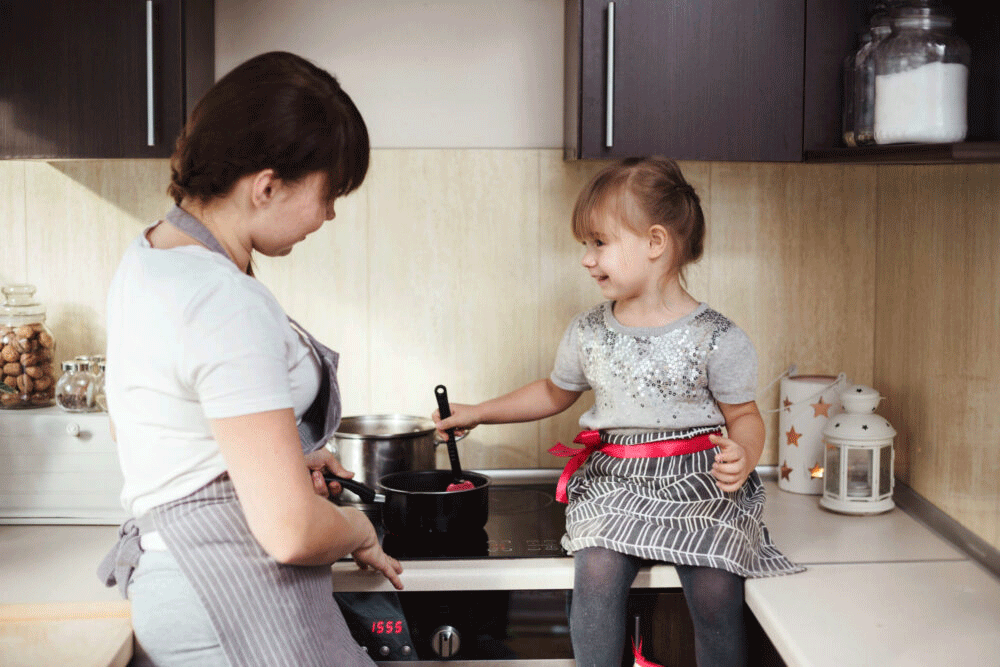
Clean Up Your Kitchen with Induction Cooking
Preparing food is often how we show love to others. But as important as the ingredients is how the food is prepared, which can make the difference between a clean, healthy kitchen or one with emissions from a gas stovetop. Did you know that emissions from gas ranges can result in unsafe levels of air toxins in our homes? At the same time, gas ranges contribute to climate change by burning or leaking methane, a powerful greenhouse gas. [1]
Induction stovetops will cook your food with clean electricity – no nasty toxins in your kitchen. These stovetops produce their heat through magnetic induction, and by doing so they are faster, safer, and more energy efficient than gas stoves or traditional electric-resistance stoves. They lower health risks, reduce greenhouse gas emissions and are easier to clean. This article will briefly explain induction stovetops, how they work, their benefits, and whether one might be the right choice for you.
How it works
An induction stove generates heat through the process of magnetic induction. This is different than a traditional electric stove, that simply passes electric current through a metal stove coil, generating heat in the coil, which then heats anything placed on top of it.

Below the visible surface of an induction stove is a metal wire, typically made of copper. When the stove is turned on, an alternating current of electricity is run through this wire. This flowing electricity causes a magnetic field around the wire and on the cooktop. If there is no pot or pan on the stovetop, nothing more happens. By itself the magnetic field does not generate any heat. However, when a metal pan is placed on the stove, the magnetic field interacts with the metal base and produces an electric current in the pan itself. Because of the resistance in the metal, the pan heats up and cooking can begin.
This process depends on the cookware being affected by the magnetic field, so only pots and pans made of magnetic materials will heat up. That means all cast-iron and most stainless-steel cookware will work, but copper pots and pans need to have a special base or coating. Click here to see a live induction demonstration that shows how cool the stovetop stays, even when there is a pan cooking food inches away!
Environmental benefits
From local air quality to worldwide climate change, transitioning from methane-gas appliances to electric ones, such as from a gas stove to an induction cooktop, can help keep our environment clean. Instead of burning methane gas and emitting harmful greenhouse gases into the atmosphere, induction stoves run on electricity, which can be generated from clean, carbon-free sources.
In a South Korean study, researchers found that increased numbers of induction stovetops lower total greenhouse emissions from cooking. [1] This is achievable in part because induction stoves are much more efficient than gas stoves. [2] More energy, upwards of 90%, is sent directly to the pot or pan and food as opposed to being lost as heat emitted into the air. By comparison, gas stoves use only 30-40% of the heat generated for cooking. [3] The greater efficiency of induction means less energy is needed in the first place.
While induction stoves can be powered from any electricity source, SVCE customers receive clean, carbon-free energy. So, for anyone in the SVCE service area, choosing an induction stove will help immediately reduce greenhouse gas emissions.
Even though switching to an electric induction stovetop may seem like it would increase your total electricity usage and bill, the efficiency gains and overall low utilization rates of stoves compared to larger appliances mean that an induction stovetop does not result in a significant increase in your electric bill.
Mountain View homeowners Clare and Eugene Cordero were motivated to make their home all-electric to reduce their carbon footprint, and they reduced their energy demand in the process. They switched over to an induction stovetop, among other electrical appliances, and increased their home’s insulation and efficiency. After going all electric, the Codero’s were happy to report that “our daily average energy use dropped from about 23kWh per day before the remodel to about 7 kWh per day after the remodel.”

Health Benefits
By avoiding increased particulate matter, induction stoves also reduce health risks compared to gas. Airborne particulate matter that is released when cooking on a gas stove is associated with a range of air-related illnesses, such as asthma. If the whole state switched from methane-gas appliances to electric ones, the reduction in particulate matter could save hundreds of lives and lower levels of illness related to airborne pollution, like bronchitis. [1]
Healthier people breathing cleaner air means fewer healthcare expenditures from illnesses caused by poor air quality. One study calculated that healthcare savings from the reduced air quality would be “equivalent to approximately $3.5 billion in monetized health benefits for just one year.” [2]
Burning methane gas in the home can also cause excessive levels of dangerous pollutants like carbon monoxide and nitrogen oxide. Research has found that these levels produced by gas stoves “can exceed the levels set by national and California-based ambient air quality standards.” [3]
This means that pollution levels inside of homes burning gas exceed what would be legal in any outdoor environment. If something were to cause these same pollution levels outside, it would be breaking state and national laws.
There are also the obvious risks of gas appliances like leaks, fires, and explosions. A home without gas appliances removes added risks of gas leaks and fires. The fact that induction stoves only heat up certain kinds of metal means the risks are much lower, and burns are less likely because, even if an induction stove is accidentally turned on, it won’t heat up without a proper pot or pan on the stovetop.
When Sunnyvale homeowner Michael Trapp wanted to remodel parts of his home, prioritizing safety led him to realize other benefits of induction: “…we bought an electric induction cooktop because we have pets and wanted the safest cooktop available. And that turned out to be more energy-efficient than our old gas stove.”[4]
[1] https://coeh.ph.ucla.edu/effects-of-residential-gas-appliances-on-indoor-and-outdoor-air-quality-and-public-health-in-california/
[2] Ibid.
[3] Ibid.
[4] https://svcleanenergy.org/michael-trapp/
Cost Benefits
Induction stoves are more efficient, so they are faster to heat up and cool down, making cooking easier and lowering the chance of burns.[1] Induction stoves are also more precise, allowing for better control while cooking, lessening your worry that the pan might be too hot or too cold; most induction stovetops can heat to a specific temperature set by the user.
As mentioned, induction stovetops only get hot when there is a conducting metal pot or pan on the stove, which means there is also a lower chance of burns (or a child accidentally melting a plastic pot on the stove). Also, since the surface does not get hot when used, any spillovers do not burn onto the surface, thereby avoiding a problem for other cooktops which require a lot of elbow grease to clean.
Many professional chefs are realizing the benefits of induction in both efficiency and comfort. Listen to a few chefs talk about why they love induction cooktops here.
[1] https://www.aceee.org/files/proceedings/2014/data/papers/9-702.pdf
Things to consider
Induction cooktops take advantage of the most recent technology to deliver a premium cooking experience. They offer added safety for families with pets and kids, while at the same time accommodating for a variety of cooking needs, even at the professional level. See Chef Jon Kung demonstrate how an induction stove is perfect for his wok cooking.
Induction stoves also offer a great level of flexibility because they come in different configurations, such as a full stovetop or as a standalone, single hob. If you are thinking about trying out induction or you are cooking in a small space, a single, portable induction cooktop may be a perfect fit. If an induction stove sounds like the right choice for you, head over to the SVCE Appliances Assistant where you can find and compare induction stovetops.


